Photo by Dondi Tawatao/Zuffa LLC
It feels almost surreal that Junior dos Santos and Alistair Overeem are finally going to meet in the Octagon. We have been so close to this dream match before that I'm reluctant to write about it even now for fear that there will be a last minute injury or drug test failure and we'll be denied the contest again.Why is it such a good match up? Well the crux of it is that Alistair Overeem has every tool necessary to be a heavyweight great, but a chin that would be of more use at a Jewish wedding. Junior dos Santos, meanwhile, is one of the biggest hitters in the history of the sport and brilliant at every offensive application of boxing but has all the lateral movement and ringcraft of a barge. It's lovely to pretend that a fighter is unbeatable until they lose, but for pure entertainment value you can't beat a pair of fighters who constantly walk a knife edge between victory and disaster.Overeem is arguably the most accomplished kickboxer in the UFC today having won a K-1 grand prix though Mark Hunt accomplished the same in 2001. Overeem was always a strange prospect for K-1 because he ended up being one of their biggest stars, but kept winning fights in a way which wasn't cricket. Early on K-1 found that Overeem could put his ear muffs on, march forwards, grab the opponent behind the head and knee them into unconsciousness. K-1 specifically changed the rules to disallow two handed collar ties just to prevent this.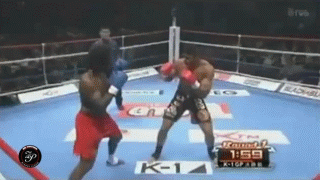
 When Overeem found himself being shown up by the polish of Remy Bonjanksy, he decided he'd simply keep throwing Bonjanksy to the floor if the referee wasn't going to do anything about it. That is not to say that Overeem was short of neat tricks in the striking department though. His cheat punches / shifting lead up-jabs that flowed into his knees, low kicks and throws are something anyone can learn from. Here's a little video highlight of some of Overeem's best work in K-1 that I put together a few years ago:The problem is that Overeem was unable to follow up on this success in the UFC. After an incredible performance against Brock Lesnar, Overeem was scheduled to fight Dos Santos who was then the heavyweight champion. After failing a drug test, Overeem was out of the game for a year and since returning he has gone 3-3, with all three losses coming by way of knockout.Sometimes this is Overeem buying his own hype, as when he came out against Antonio Silva pretending to be a world-class boxer and ducked onto an uppercut which put him on wobbly legs. Sometimes it is his way of lumbering forward across the ring and relying on the protection of the gloves which aren't there in MMA—as when Travis Browne showed him five front snap kicks before finally landing one on his jaw. And most recently it was down to timidity as Overeem perhaps started to believe the talk around his own chin and looked to hit and run against Ben Rothwell, again ducking onto a punch.
When Overeem found himself being shown up by the polish of Remy Bonjanksy, he decided he'd simply keep throwing Bonjanksy to the floor if the referee wasn't going to do anything about it. That is not to say that Overeem was short of neat tricks in the striking department though. His cheat punches / shifting lead up-jabs that flowed into his knees, low kicks and throws are something anyone can learn from. Here's a little video highlight of some of Overeem's best work in K-1 that I put together a few years ago:The problem is that Overeem was unable to follow up on this success in the UFC. After an incredible performance against Brock Lesnar, Overeem was scheduled to fight Dos Santos who was then the heavyweight champion. After failing a drug test, Overeem was out of the game for a year and since returning he has gone 3-3, with all three losses coming by way of knockout.Sometimes this is Overeem buying his own hype, as when he came out against Antonio Silva pretending to be a world-class boxer and ducked onto an uppercut which put him on wobbly legs. Sometimes it is his way of lumbering forward across the ring and relying on the protection of the gloves which aren't there in MMA—as when Travis Browne showed him five front snap kicks before finally landing one on his jaw. And most recently it was down to timidity as Overeem perhaps started to believe the talk around his own chin and looked to hit and run against Ben Rothwell, again ducking onto a punch.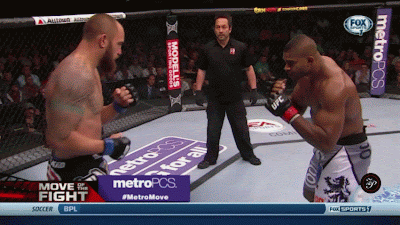 Meanwhile Junior dos Santos has still not lost to anyone but Cain Velasquez in the UFC but fans and pundits are slowly coming to recognize that he might not be the cream of the crop any more. It used to be unthinkable that Dos Santos would lose to anyone but the champion, but he consistently shows the same exploitable flaws. When Dos Santos lost to Velasquez for the first time it had come after nine UFC victories, seven finishes, and hardly a round that could be scored against Dos Santos. Every fight since his first Velasquez loss has seen him take heavy blows and be forced to 'dig deep' in order to win.Dos Santos' problem is simple to identify: he can't stay off the fence. He has almost zero ring awareness and backs himself onto the fence with just a little encouragement from his opponent. His back foot hits the fence and he only then begins circling out. It is vital for a boxer to get a feel for how far he is from the ropes, and one way that this is taught is to look at the opposite ropes as an aid to identifying ring position. In MMA, this just isn't taught and isn't properly grasped by the vast majority of fighters. I've seen top ten fighters in the UFC look behind them to check where the fence is as they retreat. It's just not good.
Meanwhile Junior dos Santos has still not lost to anyone but Cain Velasquez in the UFC but fans and pundits are slowly coming to recognize that he might not be the cream of the crop any more. It used to be unthinkable that Dos Santos would lose to anyone but the champion, but he consistently shows the same exploitable flaws. When Dos Santos lost to Velasquez for the first time it had come after nine UFC victories, seven finishes, and hardly a round that could be scored against Dos Santos. Every fight since his first Velasquez loss has seen him take heavy blows and be forced to 'dig deep' in order to win.Dos Santos' problem is simple to identify: he can't stay off the fence. He has almost zero ring awareness and backs himself onto the fence with just a little encouragement from his opponent. His back foot hits the fence and he only then begins circling out. It is vital for a boxer to get a feel for how far he is from the ropes, and one way that this is taught is to look at the opposite ropes as an aid to identifying ring position. In MMA, this just isn't taught and isn't properly grasped by the vast majority of fighters. I've seen top ten fighters in the UFC look behind them to check where the fence is as they retreat. It's just not good. Velasquez was the one who really made use of the fence and punished Dos Santos when he got there, but the same flaws in ringcraft were repeatedly shown by Stipe Miocic and by Mark Hunt.
Velasquez was the one who really made use of the fence and punished Dos Santos when he got there, but the same flaws in ringcraft were repeatedly shown by Stipe Miocic and by Mark Hunt.
 Dos Santos' attitude has always been that even if he is backed up, he will keep punching. This means he considers circling out far, far too late. Sometimes this works out well, as when he landed his fight changing left hook against Miocic as the latter pushed towards the fence again.
Dos Santos' attitude has always been that even if he is backed up, he will keep punching. This means he considers circling out far, far too late. Sometimes this works out well, as when he landed his fight changing left hook against Miocic as the latter pushed towards the fence again. Other times, as against Cain Velasquez, it will simply get Dos Santos hit and dragged into the clinch with ease. Notice in the clip below that Dos Santos is already too close to the fence, he should be circling already, but he stands still and tries to hit Velasquez with a jab instead. There is almost no point to jabbing from there, Dos Santos is in motion backwards, can't get any power behind it, and is just providing Velasquez an opening.
Other times, as against Cain Velasquez, it will simply get Dos Santos hit and dragged into the clinch with ease. Notice in the clip below that Dos Santos is already too close to the fence, he should be circling already, but he stands still and tries to hit Velasquez with a jab instead. There is almost no point to jabbing from there, Dos Santos is in motion backwards, can't get any power behind it, and is just providing Velasquez an opening.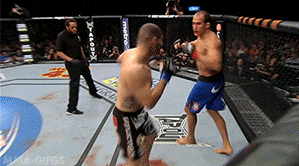 Now popular opinion says that in a match between Alistair Overeem and Junior dos Santos, Overeem should be put to sleep early. There's the usual "Dos Santos only has to connect once!" and in fairness, Overeem has shown himself to be lumbering and hittable. Overeem's tendency to walk forward and bend forward with his earmuffs on in answer to almost any attack is doubly concerning…
Now popular opinion says that in a match between Alistair Overeem and Junior dos Santos, Overeem should be put to sleep early. There's the usual "Dos Santos only has to connect once!" and in fairness, Overeem has shown himself to be lumbering and hittable. Overeem's tendency to walk forward and bend forward with his earmuffs on in answer to almost any attack is doubly concerning…
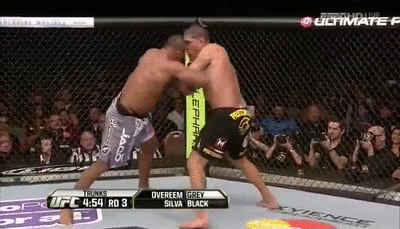
 …when you consider that Dos Santos' slapping left hook on the glove to right uppercut is one of his most beloved set ups.
…when you consider that Dos Santos' slapping left hook on the glove to right uppercut is one of his most beloved set ups.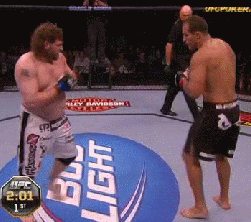 However, just as Dos Santos' strength matches up perfectly with Overeem's weakness, Overeem is the perfect man to exploit Dos Santos' own flaw if he can get there. Where Velasquez relies on work rate along the fence rather than the quality of his strikes, Stipe Miocic wasn't able to do much, and Mark Hunt had no interest in being there, Alistair Overeem is one of the most powerful and effective strikers in the clinch along the fence of anyone in the game.The people who have followed Overeem since his early days know what's up. When he was a gangly kid getting beaten up by the best in the world in PRIDE, Overeem was just a few goofy punches and kicks with some of the best knees you've ever seen attached. His best performances came when he got his opponent to the ground, or grabbed a collar tie, or got them in a clinch and battered them with knees.
However, just as Dos Santos' strength matches up perfectly with Overeem's weakness, Overeem is the perfect man to exploit Dos Santos' own flaw if he can get there. Where Velasquez relies on work rate along the fence rather than the quality of his strikes, Stipe Miocic wasn't able to do much, and Mark Hunt had no interest in being there, Alistair Overeem is one of the most powerful and effective strikers in the clinch along the fence of anyone in the game.The people who have followed Overeem since his early days know what's up. When he was a gangly kid getting beaten up by the best in the world in PRIDE, Overeem was just a few goofy punches and kicks with some of the best knees you've ever seen attached. His best performances came when he got his opponent to the ground, or grabbed a collar tie, or got them in a clinch and battered them with knees.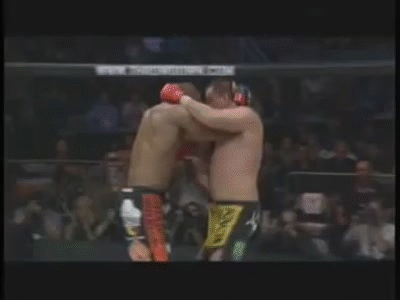

 Travis Browne, recipient of these knees, noted immediately afterwards that he had never felt anything like them in his life. It was the same left knee which winded Brock Lesnar in 2011 as sent Bazigit Atajev through the ropes in Overeem's second PRIDE fight back in 2002. These, not his kickboxing craft, have won Overeem the big matches. Not only can so few fighters knee effectively, even fewer can do it from clinches, and goodness knows that heavyweights in peak shape still gas out, body work is more valuable in that division than anywhere else.The way to take away Dos Santos' power is to crush his stance along the fence—in fact we used him as the textbook example in the first episode of Ringcraft:It is, therefore, in Overeem's best interest to get to the fence early—where Dos Santos cannot hit effectively and where Overeem can. With that being said, the sole improvement Dos Santos made between the second and third fights with Velasquez was the addition of a couple of beautiful little elbows from the flattened position along the fence. Each time Dos Santos was able to stiff arm Velasquez's head out to arms length, he knew Velasquez was going to drive back in as hard as he could, and he made sure that there was an elbow in the way.
Travis Browne, recipient of these knees, noted immediately afterwards that he had never felt anything like them in his life. It was the same left knee which winded Brock Lesnar in 2011 as sent Bazigit Atajev through the ropes in Overeem's second PRIDE fight back in 2002. These, not his kickboxing craft, have won Overeem the big matches. Not only can so few fighters knee effectively, even fewer can do it from clinches, and goodness knows that heavyweights in peak shape still gas out, body work is more valuable in that division than anywhere else.The way to take away Dos Santos' power is to crush his stance along the fence—in fact we used him as the textbook example in the first episode of Ringcraft:It is, therefore, in Overeem's best interest to get to the fence early—where Dos Santos cannot hit effectively and where Overeem can. With that being said, the sole improvement Dos Santos made between the second and third fights with Velasquez was the addition of a couple of beautiful little elbows from the flattened position along the fence. Each time Dos Santos was able to stiff arm Velasquez's head out to arms length, he knew Velasquez was going to drive back in as hard as he could, and he made sure that there was an elbow in the way. With no stance to speak of, but with a solid piece of bone as the connecting surface and Velasquez providing all the force, JDS managed to wobble his man from an extremely disadvantageous position. Of course, it takes a good deal of exertion to push a man out to arms length, and it doesn't take nearly as much to lean on one, so the technique came infrequently and had little effect on the course of the bout.With this bout coming so late—after JDS has taken some nasty beatings and Overeem has been knocked out three more times—I can't help but feel sad about what we missed. That being said, its still two of the best heavyweights in the world and two of the best finishers to ever grace the sport with Dos Santos working at an 82% finishing rate and Overeem holding his at a very respectable 90%. It is terrible to guarantee viewers a finish and then be treated to fifteen tedious minutes (nobody is clamouring for heavyweight fights to go the distance) but if ever you could point to one fight and say "I can't see this going the distance", it's Overeem versus Dos Santos.
With no stance to speak of, but with a solid piece of bone as the connecting surface and Velasquez providing all the force, JDS managed to wobble his man from an extremely disadvantageous position. Of course, it takes a good deal of exertion to push a man out to arms length, and it doesn't take nearly as much to lean on one, so the technique came infrequently and had little effect on the course of the bout.With this bout coming so late—after JDS has taken some nasty beatings and Overeem has been knocked out three more times—I can't help but feel sad about what we missed. That being said, its still two of the best heavyweights in the world and two of the best finishers to ever grace the sport with Dos Santos working at an 82% finishing rate and Overeem holding his at a very respectable 90%. It is terrible to guarantee viewers a finish and then be treated to fifteen tedious minutes (nobody is clamouring for heavyweight fights to go the distance) but if ever you could point to one fight and say "I can't see this going the distance", it's Overeem versus Dos Santos.
Advertisement


Advertisement

Advertisement








Advertisement




Advertisement

